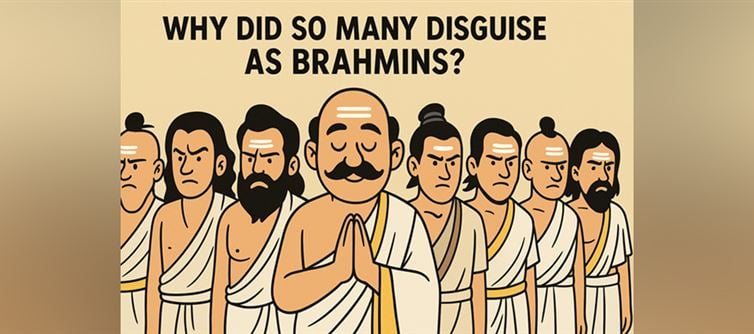
🔥 The Disguise That Could Open Any Door
Across Ramayana, Mahabharata, and countless Puranic stories, there’s a pattern so striking that once you notice it, you can’t unsee it:
Heroes, villains, gods, demons — everyone chose the same disguise when they needed unquestioned trust.
A Brahmin.
From Ravana’s abduction plot, to Krishna’s strategy, to Bhima’s mission, to Indra’s deception, to Vishnu’s test — the most divine, the most noble, and even the most devious beings used the Brahmin identity as their cloak.
Not because of caste power.
Not because of privilege.
But because in the ancient imagination, “Brahmin” meant knowledge, purity, truth, and moral authority — the one identity no one doubted.
And that reverence… was both a strength and a vulnerability.
📜 The Epics Reveal a Pattern: Everyone Trusted a Brahmin
Why did Ravana become a Brahmin to deceive Sita?
Why did Hanuman disguise himself as one to find Sita?
Why did krishna appear as a Brahmin to teach Karna a harsh truth?
Why did Bhima become a Brahmin to challenge Jarasandha?
Simple: A Brahmin was seen as a carrier of wisdom, someone who never approached with malice, and someone whose intentions were beyond suspicion.
That trust could open doors that even divine power couldn’t.
🧠 Brahmin = The Symbol of Knowledge, Not the Symbol of Birth
In the epics, “Brahmin” is not a birth identity — it’s an archetype:
A seeker of truth.
A person of learning.
Someone who protected knowledge and upheld dharma.
Even gods chose this form when they needed to appear:
• soft
• harmless
• trustworthy
• wise
• neutral
It was the one form every king, queen, demon, warrior, and ascetic respected.
That’s why disguise worked.
😈 When dharma Used the Brahmin Form… and So Did Adharma
The fascinating twist is that both sides used this identity:
✔ Gods used it to test integrity
✔ Heroes used it to strategize
✔ Villains used it to deceive
✔ Kings trusted it without hesitation
This duality shows something profound:
A reputation built on virtue can be powerful enough to be weaponized.
It was never about caste supremacy.
It was about the moral capital associated with learning and righteousness.
⚡ The Reputation That Became a Shortcut — Even in Ancient Times
The respect for a Brahmin’s word was so deep that even the worst-intentioned people knew:
“If I become a Brahmin, no one will question me.”
This shows a flaw not in Brahmins, but in human nature:
We judge by symbols, not by actions.
We trust robes, not character.
We believe appearances, not intentions.
And this weakness has survived centuries.
📉 The Trust Still Exists — But the Blind Trust Shouldn’t
Even today, society often associates:
• teacher = trustworthy
• priest = pure
• scholar = selfless
• guru = enlightened
But history — and mythology — warn us repeatedly:
Don’t trust the symbol. Trust the person.
Modern scams, scandals, and manipulations are nothing but echoes of the same ancient pattern.
Where trust exists, someone will always try to exploit it.
🕉 The Timeless Message: Truth > Titles, Wisdom > Labels
Your closing thought is the core truth every era needs:
Integrity is not worn; it is lived.
Wisdom is not inherited; it is earned.
Respect belongs to the righteous, not the robe.
A Brahmin was revered not for birth identity,
but for the pursuit of truth, self-discipline, and knowledge.
Anyone who embodies those values earns the same respect, regardless of caste, class, or background.
✨ Let Reverence Be Based on Character, Not Costume
Whether it was vishnu testing Mahabali, indra deceiving Karna, or the Pandavas seeking anonymity, the Brahmin disguise worked because it symbolized the highest ideals of human virtue.
But mythology also warns that symbolism can be misused.
The lesson for today?
Don’t be blinded by labels.
Don’t be manipulated by appearances.
Respect those who live truth, not just those who look the part.
Knowledge, character, and righteousness belong to everyone who chooses them.




 click and follow Indiaherald WhatsApp channel
click and follow Indiaherald WhatsApp channel